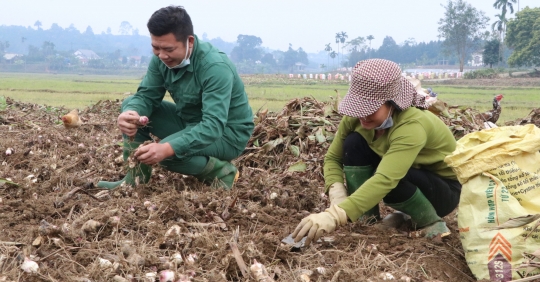Visiting Vermicelli Village in Quy Mong Township (Tran Yen District, Yen Bai Province) these days, just before the 2023 Lunar New Year, the atmosphere is crowded and bustling, spreading across the villages, houses become in the fields and workshops harvested Starch processing works around the clock at full speed. The vermicelli factories are also actively producing new batches of vermicelli in order to have enough product to supply the market during the Lunar New Year.
Located along the Red River flowing through with a length of nearly 10 km, dozens of hectares of riverside agricultural land in Quy Mong Township are annually filled with fertile alluvium suitable for crop cultivation, especially suitable for crop cultivation , suitable for galangal. Over the years, local authorities have encouraged people to convert inefficient rice land, home garden land, and fertile land into concentrated areas for galangal cultivation.
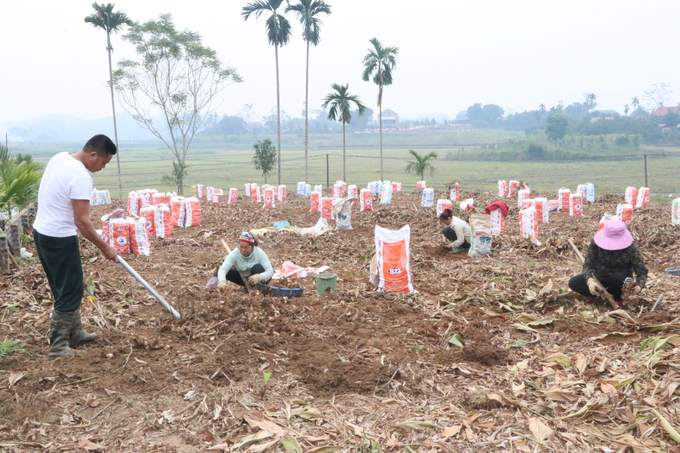
The people of Quy Mong township are filled with joy during the galangal harvesting season in the last days of 2022. Photo: Than Tien.
At the same time, support households to boldly invest in the construction of vermicelli processing plants to generate value, income and job creation for farm workers. Step by step built a craft village for processing galangal flour and vermicelli.
Ms. Vu Thi Hue from Thinh Hung Village in Quy Mong Township shared, “My family started cultivating galangal in 2016, previously corn was mainly cultivated in this area. In 2022, my family planted 10 Sao Galangal, the yield of which was about 30 tons of tubers, after renting starch processing factories, I sold them to vermicelli manufacturing plants in the community. This year, thanks to galangal, my family earns almost VND 50 million, 2-3 times more than growing corn and rice.
In 2022, the galangal cultivation area in Quy Mong township will reach more than 70 hectares, mainly in villages like Thinh Loi, Thinh An and Thinh Binh. The income from the cultivation of galangal is currently 100-115 million VND/ha after deducting interest expenses of 60-70 million VND/ha. Previously, people in Quy Mong Township mainly grew galangal nodules and sold them to merchants to buy and process starch. About 4-5 years ago people started renting factories to process starch and then sell it at a better price.
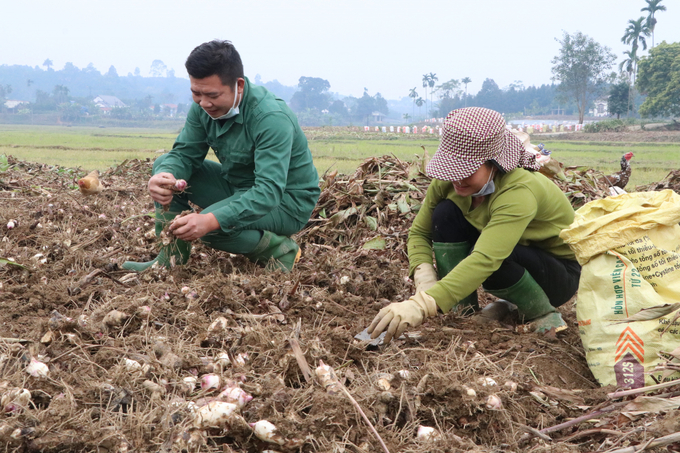
Vu Thi Hue and her husband in Thinh Hung village (Quy Mong commune) harvest galangal tubers in joy of a good harvest. Photo: Than Tien.
At present, there are 4 galangal starch pre-processing factories in Quy Mong Municipality, on average, each workshop can process 15-20 tons of galangal root, which is about 4 tons of starch. Flour processing plants are continuously upgraded from the stage of tubers sifting and washing, grinding, filtering to powder settling, and providing Dong powder processing services for 100% of the annual output of galangal tubers harvested in the municipality, invested.
Mr. Phi Dac Hung, owner of a starch processing factory in Thinh Loi Village, said galangal is an easy crop to grow, is not picky about the soil and can take advantage of the hilly and sandy soil areas in addition to the territory. Galangal can always be mixed with another crop of corn or soybeans.
Many years ago, the people of Quy Mong only grew galangal trees to process fodder for livestock and poultry, the rest selling the tubers to Dong powder processing plants in the lower provinces and in the Phuc Loc and Gioi Phien communes in the Yen Bai City to make vermicelli. Few households know how to process galangal into vermicelli for sale in the market.
“With government support, we now have starch factories and then supply them to co-ops and local vermicelli factories. This has enhanced the value of the products and improved people’s income,” said Mr. Hung.
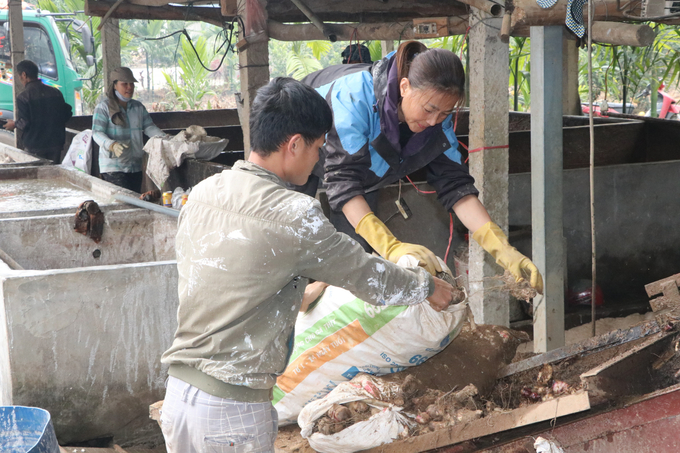
After washing, galangal nodules are taken to processing plants to make dong starch for vermicelli. Photo: Than Tien.
Recently, Quy Mong Township has mobilized people to maintain the area and form a large resource area to produce commodities from growing and processing starch to making vermicelli. Local authorities continue to actively coordinate with relevant authorities to apply scientific and technical advances to production; Formation of production groups, groups and cooperatives to facilitate the establishment of legal status, credit, brand promotion, linked with deep processing and product trade …
At the same time, coordinate with the district and provincial functional authorities to support more machinery and equipment to build more noodle manufacturing plants in the area. Up to now, Quy Mong Township has 4 vermicelli production bases, vermicelli is sold stably at an average price of VND 50,000-60,000/kg. Specifically, there are currently 2 vermicelli products in the municipality of Viet Hai Dang Cooperative and Toan Nga Green Startup Cooperative, which have been recognized as 3-star OCOP products at the provincial level.
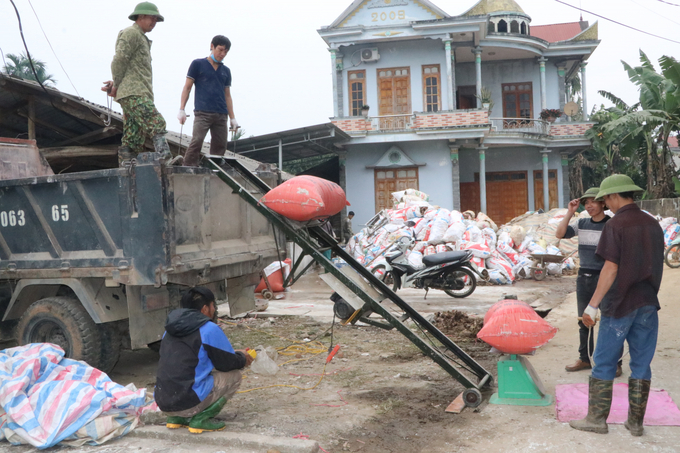
Starch processors buy galangal for humans. Photo: Than Tien.
After being recognized as OCOP products, municipal authorities have actively coordinated with cooperatives to build brands and promote products, and placed these products on e-commerce booths to encourage consumption inside and outside the province.
Mr. Phung Tien Hien, Vice Chairman of Quy Mong Township People’s Committee, added, “We have and will continue to coordinate with specialized authorities in the district to train and guide galangal farmers to apply mechanization in agriculture. Development of the raw material area for galangal nodules according to VietGAP standards. On the other hand, the formation of more cooperative groups and cooperatives in the cultivation, processing and consumption of dong flour and vermicelli products with stable prices for people. At the same time, encourage and support households to boldly invest in the construction of vermicelli processing plants, increase income and create jobs for farm workers.”
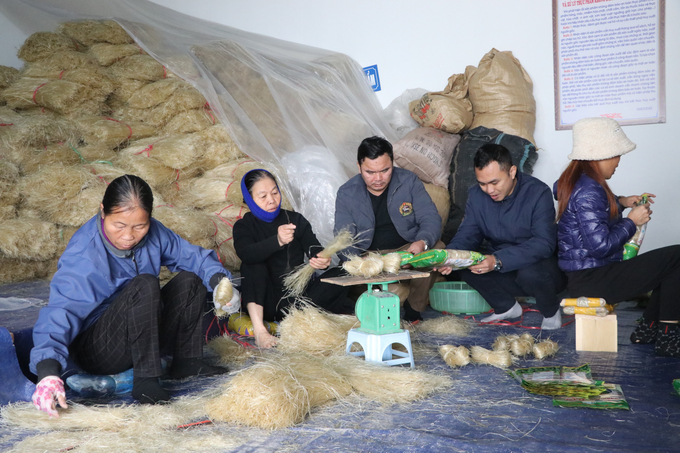
Toan Nga Green Startup Cooperative buys starch to make vermicelli. Photo: Than Tien.
The goal of Quy Mong community is that when there are many households making vermicelli, they establish a craft village to process dong starch and vermicelli, and upgrade Quy Mong vermicelli OCOP products from 3 stars to 4 stars. The municipality aims to have more vermicelli production bases from 2021 to 2025, whereby the share of dong flour in vermicelli processing in the municipality will reach 50%, equivalent to more than 200 tons of starch per year; Developing more vermicelli products that meet OCOP standards.

